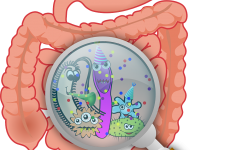The Power of the Bug
By now, many of you who have followed my blogs probably have a pretty good understanding of
how important the microbiome is. In case you need a refresher, here’s a little overview of what it is from the Human Microbiome Project,1 a research initiative with the aim of determining the composition and the impact of these trillion tiny friends in our body and on our health:
The Human Microbiome is the collection of all the microorganisms living in association with the human body. These communities consist of a variety of microorganisms including eukaryotes, archaea, bacteria and viruses. Bacteria in an average human body number ten times more than human cells, for a total of about 1000 more genes than are present in the human genome. Because of their small size, however, microorganisms make up only about 1 to 3 percent of our body mass (that’s 2 to 6 pounds of bacteria in a 200-pound adult). These microbes are generally not harmful to us, in fact they are essential for maintaining health. For example, they produce some vitamins that we do not have the genes to make, break down our food to extract nutrients we need to survive, teach our immune systems how to recognize dangerous invaders and even produce helpful anti-inflammatory compounds that fight off other disease-causing microbes. An ever-growing number of studies have demonstrated that changes in the composition of our microbiomes correlate with numerous disease states, raising the possibility that manipulation of these communities could be used to treat disease. 1
Two notes regarding the definition above:
1. the microbiota is technically the term for all the tiny critters and the microbiome is the sum of their genetic material and how their little functions impact our body and health.2
2. there was a recent study that called into question the 10 to 1 ratio of bugs to cells. You can read the controversy on this site here.
However, it’s not the amount of bugs that make for the impact of the microbiome, but all their functions. Yup, the little buggers are everywhere from head to toe and have a profound impact on our health. These critters that reside in our insides, line the surfaces of our body,3 inhabit our oral cavity,4 and even surround us in their buggy microbial crowd.
Buggy Digestion
Besides their vast amounts of other functions, the microbiota in our guts have digestive prowess. According to a 2015 article in the World Journal of Gastroenterology, our belly bugs help break down carbohydrates for their own benefits while producing short chain fatty acids and other helpful metabolites for their host:
Fermentation of the carbohydrates that escaped proximal digestion and indigestible oligosaccharides by colonic organisms such as Bacteroides, Roseburia, Bifidobacterium, Fecalibacterium, and Enterobacteria result in the synthesis of short chain fatty acids (SCFA) such as butyrate, propionate and acetate, which are rich sources of energy for the host. Furthermore, butyrate can prevent the accumulation of toxic metabolic by-products such as D-lactate[38]. Members of the genus Bacteroides, which are the predominant organisms that participate in carbohydrate metabolism, perform this by expressing enzymes such as glycosyl transferases, glycoside hydrolases and polysaccharide lyases. The best example among these organisms is Bacteroides thetaiotaomicron that is endowed with a genome that codes for over 260 hydrolases, which is far more than the number encoded by the human genome[39]. The oxalate that is synthesized in the intestine as a result of carbohydrate fermentation and bacterial metabolism is countered by organisms such as Oxalobacter formigenes, Lactobacillus species, and Bifidobacterium species thereby reducing the risk of formation of oxalate stone in the kidney[40,41].5
According to the same article, these little critters also aid with lipid metabolism, are enriched with “protein metabolizing machinery,” have been shown to elevate pyruvic acid, citric acid, fumaric acid and malic acid, all of which are indicators of higher energy metabolism, and synthesize vitamin K and B vitamins. Different species can also produce conjugated linoleic acid, assist with secondary bile acid formation, and they help break down polyphenols!
Now, what happens when bad bugs overpopulate our bellies? Do we kill them off? In my homepage blog, I discuss the use of essential oils for digestive health and how they may prevent the negative consequences of “microbe destruction.” Click here to read this and more!
References:
1.HMP. About the HMP. NIH (National Institute of Health) Human Microbiome Project (HMP). http://hmpdacc.org/overview/about.php
2. Ursell LK, Metcalf JL, Parfrey LW, Knight R. Defining the Human Microbiome. Nutrition reviews. 2012;70(Suppl 1):S38-S44. doi:10.1111/j.1753-4887.2012.00493.x.
3. Grice EA, Segre JA. The skin microbiome. Nature reviews Microbiology. 2011;9(4):244-253.
doi:10.1038/nrmicro2537.
4. He J1, Li Y, Cao Y, Xue J, Zhou X. The oral microbiome diversity and its relation to human diseases. Folia Microbiol (Praha). 2015 Jan;60(1):69-80. doi: 10.1007/s12223-014-0342-2.
5. Jandhyala SM, Talukdar R, Subramanyam C, Vuyyuru H, Sasikala M, Reddy DN. Role of the normal gut microbiota. World Journal of Gastroenterology : WJG. 2015;21(29):8787-8803. doi:10.3748/wjg.v21.i29.8787.



